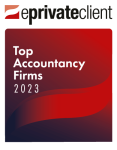3rd April 2024
For financial services businesses, understanding the VAT rules is crucial for maintaining compliance and optimising tax efficiency. This article aims to demystify the basics of VAT as it applies to financial services, guiding businesses through the complexities of VAT recovery, exemptions, and the nuanced calculations required for partial exemption and attribution of residual costs.
The impact of VAT and exemptions
VAT presents unique challenges for the sector. Given the intangible nature of many financial products, determining the applicability of VAT can be complex. The impact of VAT on FS businesses is multifaceted, affecting pricing strategies, service delivery models, and overall tax compliance.
Many financial services are exempt from VAT in the UK. This exemption covers a wide range of services, including insurance, granting of credit, certain transactions in securities, and others. In HMRC’s guidance, debt collection services or certain portfolio management services are VATable. When a supply is classed as VAT exempt however, no VAT is charged on the sale of that service to the customer. Banking services and certain types of investment activities often fall into this category and other VAT regimes globally.
VAT recovery in financial services businesses
While VAT exemption can make services more competitively priced (as there is no VAT to pass on to the customer), it also means the provider cannot recover VAT on purchases related directly to these exempt supplies, leading to a potential increase in overhead costs. Therefore, the extent to which FS businesses can recover VAT is limited by the nature of their exempt supplies. Effective VAT recovery strategies are essential for FS businesses to manage their tax liabilities and enhance profitability.
Partial exemption, direct attribution, and residual costs
For FS businesses that make both taxable and exempt supplies, navigating VAT implications requires a nuanced approach. Partial exemption rules allow businesses to recover VAT on purchases to the extent that they are used to make taxable supplies. This involves a two-step process:
- Direct attribution: Costs are first analysed to determine whether they can be directly attributed to taxable or exempt supplies.
- Residual costs: Costs that cannot be directly attributed (residual costs) are then apportioned between taxable and exempt activities, using a fair and reasonable method.
Determining the correct amount of VAT that can be recovered under partial exemption rules requires careful calculation and can impact the business’ overall VAT liability.
The turnover method
The standard method for calculating recoverable VAT on residual costs is based on the turnover of the business. This method apportions residual input VAT in line with the proportion of the business’ taxable supplies to its total supplies. While this method is commonly applied, it may not always reflect the actual use of goods and services. Businesses can apply for a special method if they believe an alternative approach better reflects their use of inputs.
Understanding your VAT obligations
Understanding the complexities of VAT within the sector is crucial for compliance and optimisation of your business’ tax position. By effectively managing VAT recovery, understanding the implications of exemptions, and accurately applying partial exemption calculations, FS businesses can position themselves for success in the competitive UK market. It is advisable for FS businesses to seek expert advice to navigate the intricacies of VAT legislation and ensure compliance with all regulatory requirements.
Contact Dougie Todd, Partner and Co-Head of VAT, for further advice.





